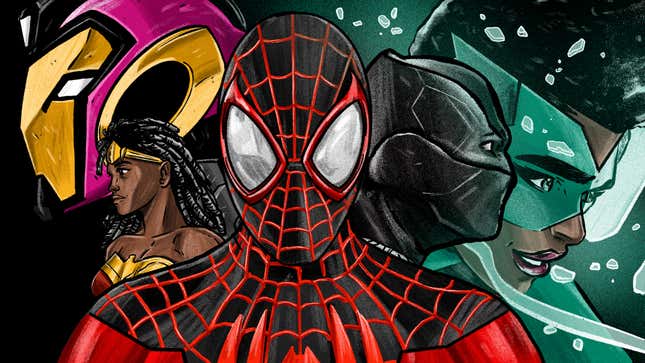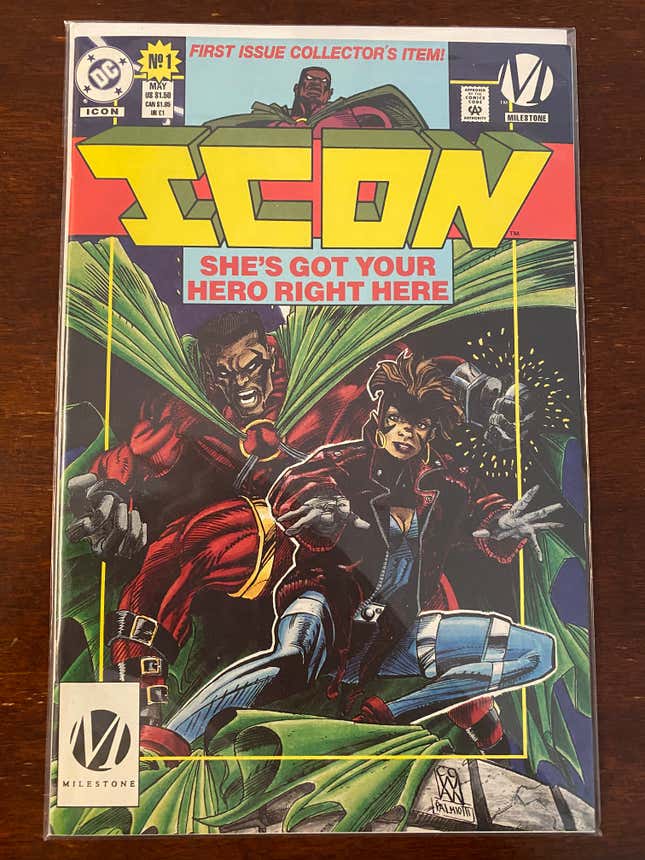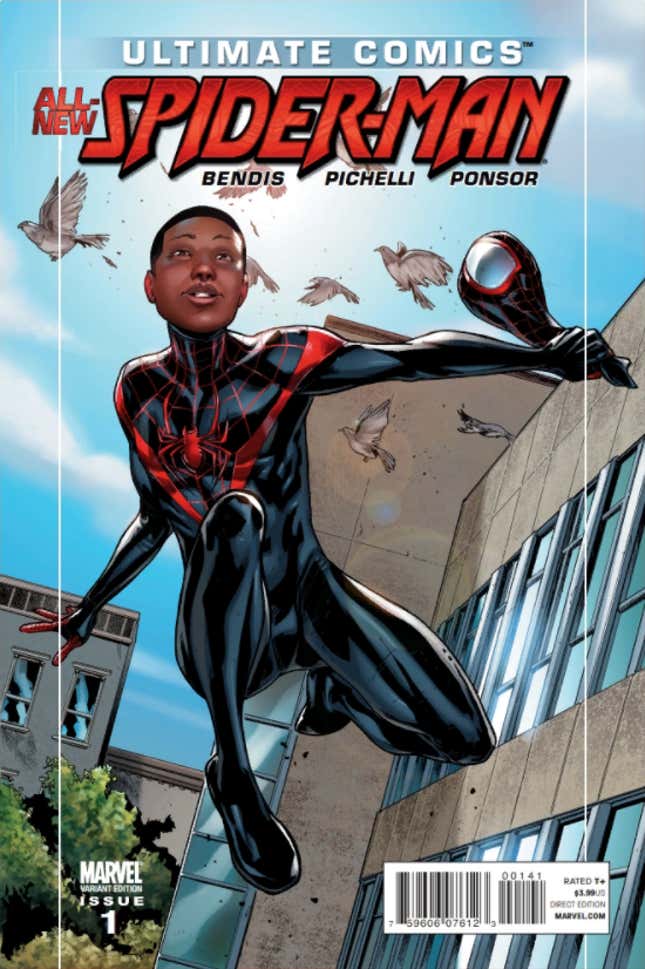
Editor’s Note: The Rise of the Black Superhero is a three-part series breaking down the past, present and future of Black superheroes across comics, film, and tv. This is part 2. Read part 1.
Welcome back, true believers! In our last thrilling adventure, the Black superhero was in dire straits. Heroes such as Black Panther and Green Lantern were left to languish on the sidelines as comics were slowly gaining in popularity. Fear not, though! A brighter future was on the horizon.
But first, let’s talk about that time the entire industry nearly went to shit a.k.a, the ‘90s.
The ‘90s: Blackest Night
The ‘90s is one of the most fascinating decades in comics history. Buoyed by hot young talents like Denys Cowan, Jim Lee, and Todd McFarlane, comics actually had heat in the early ‘90s. Like massive heat.
To put it into perspective for you, most books these days are happy to sell copies in the six figures. X-Men Vol. 2, Issue 1, released in 1991, sold 8.5 million copies, becoming the best-selling comic of all time.
So yeah, folks were fucking with the books.
Even as the industry was booming, there wasn’t much priority surrounding Black superheroes. In an effort to address this lack of Black comics, Dwayne McDuffie, Denys Cowan, Michael Davis, and Derek T. Dingle would create Milestone Media in 1993.

It was a new imprint that focused on telling stories from perspectives of color. They were modern, cool, and most importantly, Black as hell. Among their early titles were Icon, a book focused on the conservative Black superhero Icon and his partner-in-herodom Rocket; Hardware, a tight-as-fuck Afrofuturist tale about a Black inventor who uses his wits (and power armor) to take down an evil corporation from the inside; and Static, a teenage boy who could manipulate electricity at will.
The Milestone books were incredibly forward-thinking and ahead of their time. They presented Blackness from a multitude of perspectives, adding a level of depth and complexity that remains impressive even to this day.
Unfortunately, timing is everything—and Milestone’s wasn’t the greatest.
You know how I said books were selling in the millions? Yeahhh, that didn’t last long. By the mid-’90s, the industry as a whole was tanking. Hard. While this sounds unthinkable in a world where Avengers: Endgame is the highest-grossing movie of all time, Marvel declared bankruptcy in 1996 and for a minute it was facing an incredibly uncertain future.
As a result of this industrywide downturn, the Milestone line would more or less fade away by the end of the ‘90s. Look, things were bad in general for the industry, so it shouldn’t come as a surprise that this wasn’t exactly a banner period for Black superheroes in the comics.
The only Black hero of this era that was consistently hitting didn’t come from Marvel or DC, but from the then-upstart Image Comics. Created by Todd McFarlane, Spawn is legitimately one of the most batshit things to come out of the ‘90s, and I mean that in the best way possible. Al Simmons, a Black man, is an assassin who dies and comes back to the world of the living after accepting a deal with the devil in order to see his wife one last time.
In the world of film, a lot of folks like to give credit to X-Men (2000) for starting the superhero cinema craze, but we’re educated folk here. We all know Bryan Singer’s “allegedly” creepy-ass ain’t start shit. Instead, that credit belongs to the 1998 action-horror banger, Blade.
Based on the Marvel Comics character of the same name, Blade was unlike anything in film at the time. As the titular “Daywalker,” you had Wesley Snipes, who embodied the role with sheer fucking gusto. Mans was so serious about the role that he was doing interviews for the movie in character.
That commitment paid off, as the movie was a visually striking, action-oriented take on the vampire genre that hadn’t really been attempted before. While it received mixed critical reception, it was a hit with audiences, grossing $131.1 million worldwide, spawning two sequels, and proving that there was an appetite for films based on comic books.
So next time you hear someone talk about X-Men or Spider-Man kicking off the superhero craze, make sure you remind them to put some respect on Blade.
The 2000s: A Rising Light
One of the consistent highlights of the early 2000s were the Black Panther books. Christopher Priest’s run would usher the character into the new millennium with a hyper-modern take on that I can only describe as cool as hell. Like seriously, look at this and tell me T’Challa ain’t a vibe:

After he left the series, Reginald Hudlin would take over the title and would guide T’Challa through a marriage to Storm and a whole-ass Civil War. Both runs would be memorable in their own right, and unlike the ‘70s and ‘80s, Black Panther would become a pretty constant presence within Marvel Comics.
On TV, Saturday morning was where it was at if you needed your Black superhero fix. From 2000-2003, I was all about that Kids WB life for one very large reason: Static Shock.
If you were a child in the ‘90s and early 2000s, then there is a very likely chance that the adventures of Virgil Hawkins and Richie Foley a.k.a Static and Gear, were appointment television for you.
I don’t think I’m being hyperbolic in saying this show meant the world to an entire generation of Black kids. I certainly know it did for me.
As a kid, you can’t really quantify why you like something, you just know you like it. But I knew I loved Static Shock simply because I believed I could be Static. There were no mental gymnastics surrounding it, the way it was when you dreamt about being Superman or Spider-Man. He looked like me, and sounded like me, so I just knew I could be him. Considering the reaction of the character’s imminent return, I get the feeling a lot of you felt that same way, too.
In addition to Static Shock holding it down, both the Justice League cartoon and its direct sequel series, Justice League: Unlimited would see John Stewart/Green Lantern glow the fuck up. My guy went from the backup-backup Green Lantern to who an entire generation first thinks of when you talk about GL.
As the decade came to a close, comics were generally in a better place, in large part due to the success of movies like Iron Man and The Dark Knight. While Black heroes were still not being prioritized, the next decade would see a half-Black, half-Puerto Rican boy from Brooklyn swing onto the scene and change the game in the process.
2010-2021: Brightest Day
In 2011, Miles Morales debuted in the pages of Ultimate Spider-Man—and white America predictably had a fit. Those folks didn’t actually read comics because if they did, they would’ve known Peter Parker was still doing his thing in Amazing Spider-Man.

Miles began his journey as Spider-Man after Peter Parker dies in his universe. The books follow Miles as he deals with the struggles of everyday teenage life while trying to live up to the legacy of Spider-Man. He was precocious, geeky, but he still had a level of cool about him, and boy, did his costume look mean.
While reality would begin its slow descent into parody, 2016 also would mark an exciting resurgence for Black characters in movies, tv, and of course, comics.
The year would see Ta-Nehisi Coates prove that beyond being a great journalist and novelist, he was a damn good comics writer too. Coates’ run on Black Panther has been consistently dope, depicting T’Challa trying to rule a Wakanda on the brink of civil war, patrolling the streets of New York with The Crew, and fighting a war against an intergalactic empire.
Riri Williams, a 15-year-old with a genius-level intellect, would build her own suit of armor and become Ironheart, with a digitized version of Tony Stark’s consciousness helping guide her on her journey to becoming an Iron Woman in her own right.
2016 would also see Marvel debut David F. Walker’s short-lived Nighthawk. Cancelled after only six issues, this is a book that was right on time for Black folk, but about three-four years too early for white America. The titular hero patrols the inner city of Chicago, spending his time wrecking white supremacists, corrupt businessmen, and crooked cops.
If you ever wished there was a hero who would brutalize the brutalizers, this book is for you.

This decade would also see the rise of the Marvel Cinematic Universe. Characters like War Machine and Falcon were in the mix, but it wouldn’t be until 2018 when a certain warrior-king would finally take center stage.
I don’t know what to say about Black Panther that hasn’t already been said. The movie was the epitome of Black joy, both within the content itself, and the reception by the audience. I remember going into the theater for this movie and my heart being so full seeing so many excited Black faces. I know you remember that feeling of joy when the credits rolled and “All the Stars” hit.
The movie was a hit, grossing well over a billion dollars, turning the “Wakanda Forever” salute into a genuine greeting, and making Chadwick Boseman forever a king in our hearts.
That year would also see Miles Morales make his big-screen debut in the incredible animated film, Spider-Man: Into the Spider-Verse. I’ve only ever cried tears of joy once in a movie, and it was during the “What’s Up Danger,” sequence. Seeing Miles, a biracial boy embrace his destiny, his power, and become Spider-Man gives me chills to this day. There’s a whole generation of Black and Brown kids who can look at Miles and see themselves. That’s a beautiful thing, y’all.
*checks word count*
Oof! I really need to wrap this up, so we’re gonna tap into the speed force right quick! On TV, we’ve seen heroes like Firestorm and Kid Flash in Legends of Tomorrow, Ryan Wilder is the new Batwoman, and ‘70s mainstays Luke Cage and Black Lightning would also get some pretty great TV adaptations, with Black creators at the helm to boot.
If you go to comic stands today, you’ll see an incredibly diverse array of books centered around Black characters. There’s Kwanza Osejyefo and Tim Smith III’s incredible indie title Black, which takes place in a world where only Black people have superpowers. (Shit is as lit as it sounds.)
David F. Walker would join forces with Chuck Brown and Sanford Greene to create Bitter Root, a genre-blending blast that follows the Sangerye family as they battle racism and monsters during the Harlem Renaissance.
At DC you have Brian Michael Bendis, David F. Walker, and Jamal Campbell’s Naomi, a reality-displaced teenage girl who low-key might be one of the most powerful heroes chilling in the DC Universe right now. Speaking of Campbell, he’s currently the artist of three-time Hugo Award-winning and MacArthur “Genius” Grant recipient N.K Jemisin’s excellent title Far Sector.
If you haven’t read Far Sector, get on it. Now. Now. It is one of the coolest stories with Black people in any medium right now. Introducing Sojourner “Jo” Mullein as a new Green Lantern, she’s sent off to the far reaches of space to investigate a murder on a planet that hasn’t experienced violence in over 500 years. The imagination, thematic depth, and concepts on display in this book have made it a joy to read month to month, and with Jo’s presence in Future State: Justice League, it’s clear she’s being positioned as the Lantern of the future.
John Ridley’s poignant The Other History of the DC Universe is an ongoing title that depicts notable events in DC’s past from the perspective of the characters of color who were often sidelined. Also, I have to give a shout-out to the excellent Nubia: Real One, a book by L.L. McKinney and Robyn Smith.
Don’t get me wrong; there is still plenty of work to be done in terms of visibility and inclusiveness, but I can’t tell you how great it feels to hit up the shop every Tuesday and usually have at least one book with a Black character, created by Black talent, waiting for me.
If you haven’t figured it out already, allow me to spell it out for you: this is the greatest era the Black superhero has ever seen. And trust me when I say the future is only looking brighter.
Next time! We take a perilous journey into the future and encounter some of the best, brightest, and Blackest talents in the game. What is the ultimate fate of the Black hero? Find out in the exciting conclusion of The Rise of the Black Superhero!